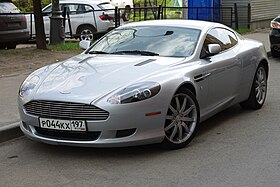
Back أستون مارتن دي بي9 Arabic Aston Martin DB9 Czech Aston Martin DB9 German Aston Martin DB9 Spanish آستون مارتین دیبی۹ Persian Aston Martin DB9 Finnish Aston Martin DB9 French Aston Martin DB9 Croatian Aston Martin DB9 ID Aston Martin DB9 Italian
| Aston Martin DB9 | |
|---|---|
 2005 Aston Martin DB9 | |
| Overview | |
| Manufacturer | Aston Martin Lagonda Limited |
| Production |
|
| Assembly | United Kingdom: Gaydon, Warwickshire |
| Designer |
|
| Body and chassis | |
| Class | Grand tourer |
| Body style |
|
| Layout | Front mid-engine, rear-wheel-drive |
| Platform |
|
| Related | |
| Powertrain | |
| Engine | 5.9 L Aston Martin V12 |
| Transmission | |
| Dimensions | |
| Wheelbase | 2,740–2,745 mm (107.9–108.1 in) |
| Length | 4,697–4,720 mm (184.9–185.8 in)[1][2] |
| Width | 2,017–2,061 mm (79.4–81.1 in)[1][2][a] |
| Height | 1,270–1,282 mm (50.0–50.5 in)[2][3] |
| Kerb weight | 1,710–1,785 kg (3,770–3,935 lb)[4] |
| Chronology | |
| Predecessor | Aston Martin DB7 |
| Successor | Aston Martin DB11 |
The Aston Martin DB9 is a two-door grand touring car produced by the British automaker Aston Martin.
Produced between 2004 and 2016, the Aston Martin DB9 was available as both a coupe and a convertible, the latter termed the "Volante". The designers of the car were Ian Callum and Henrik Fisker, who also worked on its descendant, the 2005 Vantage. The DB9 is the successor to the DB7, which Aston Martin produced from 1994 until 2004. The DB9 debuted at the Frankfurt Motor Show in 2003, while the Volante debuted at the same motor show in the subsequent year. It was produced in Gaydon, a village in Warwickshire. The company built the car's chassis upon the vertical/horizontal platform, which employed extensive use of aluminium throughout the body.
Aston Martin implemented several incremental updates to the DB9, termed "facelifts". The first two updates, in 2008 and 2010, involved minor changes to the headlights, tail-lights, engine and interior. The most noteworthy update occurred in 2012 when Aston Martin introduced a completely redesigned front fascia for the DB9. The headlights were the most significant update, which gave the car a design reminiscent of the 2011–2012 Virage. The company's racing division, Aston Martin Racing, adapted the DB9 for sports car racing in the form of the DBR9 and the DBRS9 for the FIA GT1 and the FIA GT3, respectively. These cars are extensively modified DB9 models adapted for motorsport; the interior features were removed, and the aluminium body panels were replaced by carbon fibre panels. The engine was modified in both cars to produce more horsepower and torque.
- ^ a b "Aston Martin DB9 V12 2dr Volante", Top Gear, BBC, archived from the original on 6 April 2024, retrieved 6 April 2024
- ^ a b c "Aston Martin DB9 V12 2dr Volante Touchtronic Auto", Top Gear, BBC, archived from the original on 6 April 2024, retrieved 6 April 2024
- ^ "Aston Martin DB9 V12 2dr", Top Gear, BBC, archived from the original on 6 April 2024, retrieved 6 April 2024
- ^ Llorella 2004, p. 124.
Cite error: There are <ref group=lower-alpha> tags or {{efn}} templates on this page, but the references will not show without a {{reflist|group=lower-alpha}} template or {{notelist}} template (see the help page).
© MMXXIII Rich X Search. We shall prevail. All rights reserved. Rich X Search